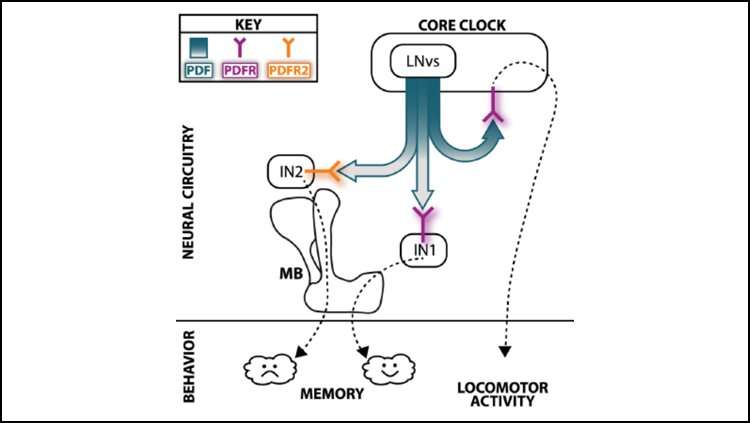The core clock regulates distinct behaviors via discrete PDF targets: a proposedmodel. Localization of PDFR to the clock permits control of locomotor activity independently from control of memory. Signaling through PDFR in a population of interneurons extrinsic to both the clock and mushroom bodies (here shown as IN1) permits regulation of appetitive memory. We propose that, in place of PDF-PDFR signaling, PDF activation of a novel unidentified receptor (here called PDFR2) in a separate population of interneurons (IN2) is required for aversive memory. Credit: Flyer-Adams et al., JNeurosci 2020
Upsetting the brain's timekeeping can cause cognitive impairments, like when jetlag makes you feel foggy and forgetful. These impairments may stem from disrupting a protein that aligns the brain's time-keeping mechanism to the correct time of day, according to new research in fruit flies published in JNeurosci.
The brain contains 'clock' neurons that mold circadian behaviors and link them to cues from the environment, like light and seasonal changes. In fruit flies, the clock releases the peptide Pigment-dispersing factor (PDF) to synchronize the activity of the clock neurons and drive time-based behaviors like mating and sleep. PDF may also underlie memory formation, explaining the cognitive dysfunction that occurs when the clock is desynchronized from the environment.
Flyer-Adams et al. tested how well fruit flies with a functioning core clock but lacking the PDF output signal could learn. Flies without PDF had severely impaired memory . However, memory regulation by PDF likely occurs without direct signaling to the main memory structure of flies.
These results suggest that PDF from the clock may promote normal memory throughout the day by acting as a timestamp to learning. The VIP pathway in humans may play a similar role.
More information: Regulation of Olfactory Associative Memory by the Circadian Clock Output Signal Pigment dispersing Factor (PDF), JNeurosci (2020). DOI: 10.1523/JNEUROSCI.0782-20.2020
Journal information: Journal of Neuroscience
Provided by Society for Neuroscience
























